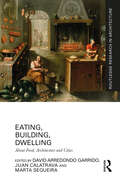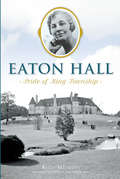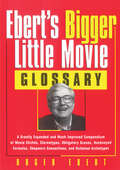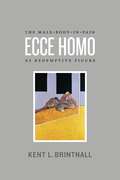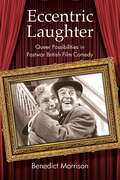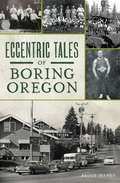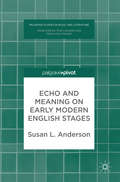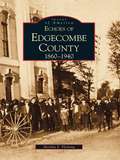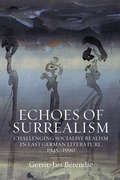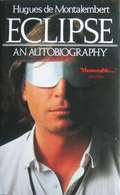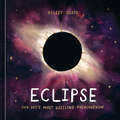- Table View
- List View
Eating, Building, Dwelling: About Food, Architecture and Cities (Routledge Research in Architecture)
by Marta Sequeira David Arredondo Garrido Juan CalatravaThe intricate relationship between food, city and architecture, spanning from ancient civilizations to the present, serves as a focal point for interdisciplinary discourse. This book delves into a diverse set of cases throughout history in which processes related to food significantly influenced architectural or urban designs.This book delineates three spatial levels — city, home and intermediate spaces — illuminating their dynamic interplay within the construct of a continually evolving “food space." Featuring 12 contributions from Mediterranean Europe, this publication explores historical legacies and contemporary challenges. Divided into urban-territorial and architectural scales, it offers nuanced insights into urban dynamics, domestic life and gastronomic tourism. Supported by a prestigious introductory study, this research advances a comprehensive understanding of food's role in shaping urban environments.Through the chapters of this book, those interested in cultural studies of food, urban history and architecture will be able to reflect on our relationship with food and its processes, and how it affects the way we live and design our cities and their architectures.
Eaton
by Mary E. MessereOnce touted as the "sparkling jewel" of Madison County because of its many scenic lakes and reservoirs built to feed the great Chenango Canal, the town and hamlet of Eaton have played an important role in the history of Madison County. From within its boundaries have come such luminaries as Emily Chubbuck Judson, early women's writer; humorist Melville Landon, better known to the world as Eli Perkins; and Samuel Chubbuck, inventor and the maker of the early telegraph equipment for Samuel Morse's telegraph. Eaton captures the history of this once-thriving community through pictures and stories of the Chenango Canal, early turnpikes, and steam engines made famous by Wood, Taber and Morse's Steam Engine Works. Many of these pictures are kept for the future in the Old Town of Eaton Museum, located in one of Eaton's oldest stone buildings.
Eaton Hall: Pride of King Township
by Steve Pellegrini Kelly MathewsIn 1901, Florence McCrea married into one of the most prosperous families in the Dominion of Canada, becoming Lady Eaton fourteen years later when her husband, John Craig Eaton, was knighted. Not long after the death of her husband, Lady Eaton retired from her home in Toronto to the seventy-two-room, Norman-style chateau she had built on their King City property. She named it Eaton Hall. The estate fueled the local economy and community, supported the Canadian World War II effort and established a firm place in the hearts and minds of the residents of King Township. Rediscover an enchanting and bygone age with the life and history of Lady Eaton and her grand Eaton Hall.
Ebert's Bests (Chicago Shorts)
by Roger EbertA treasury of year-by-year ten-best lists, plus personal reminiscences by the man whose name became synonymous with the movies. In Ebert&’s Bests, the iconic Roger Ebert takes us through the journey of how he became a film critic, from his days at a student-run cinema club to his rise as a television commentator in At the Movies and Siskel & Ebert. Recounting the influence of the French New Wave; his friendships with Werner Herzog and Martin Scorsese; and travels to Sweden and Rome to visit Ingrid Bergman and Federico Fellini, Ebert never loses sight of film as a key component of our cultural identity. In considering the ethics of film criticism—why we should take all film seriously, without prejudgment or condescension—he argues that film critics ought always to engage in open-minded dialogue with a movie. All this is accompanied by decades&’ worth of annual ten-best lists, which showcase Roger Ebert&’s recommendations—while at the same time reminding us that hearts and minds, and even rankings, are bound to change.
Ebert's Bigger Little Movie Glossary: A Greatly Expanded and Much Improved Compendium of Movie Clichés, Stereotypes, Obligatory Scenes, Hackneyed Formulas, ... Conventions, and Outdated Archetypes
by Roger EbertAn expanded glossary of movie clichés from the Pulitzer Prize–winning film critic. The popular film critic offers a compilation of witty and wise observations about the film lexicon, including “Fruit Cart,” a chase scene through an ethnic or foreign locale, or “The Non-Answering Pet,” referring to a dead pet in a horror movie.
Ecart (19691980)
by Lionel Bovier Christophe Cherix"(Curating) From A to Z" offers a summary of the development of curatorial practice over the last two decades seen through the eyes of curator Jens Hoffmann. <P><P>In this publication each letter of the alphabet evokes a particular word related to the world of exhibition making: From A (as in Artist) and B (as in Biennial) to R (as in Retrospective) and W (as in White Cube). Employing a diarist style, the curator presents his personal curatorial alphabet with a similar transparency and the same idiosyncratic character revealed in many of his exhibitions. The entries are not only stimulating and intellectually rigorous, but also emotionally engaging.Jens Hoffmann (b. 1974 in San Jose, Costa Rica) is a writer, exhibition maker, and educator. He currently is Deputy Director of The Jewish Museum, New York. He has published widely in journals and museum publications and has written over 200 texts on art and exhibition making over the last 15 years. <P>His most recent books include "The Studio" (2012), as well as "Show Time: A History of Exhibitions" (2014). He is the founder and editor of "The Exhibitionist: Journal on Exhibition Making." Most recently he co-curated the 9th Shanghai Biennial (2012/13) and the 12th Istanbul Biennial (2011).
Ecce Homo
by Kent L. BrintnallImages of suffering male bodies permeate Western culture, from Francis Bacon’s paintings and Robert Mapplethorpe’s photographs to the battered heroes of action movies. Drawing on perspectives from a range of disciplines—including religious studies, gender and queer studies, psychoanalysis, art history, and film theory—Ecce Homo explores the complex, ambiguous meanings of the enduring figure of the male-body-in-pain. Acknowledging that representations of men confronting violence and pain can reinforce ideas of manly tenacity, Kent L. Brintnall also argues that they reveal the vulnerability of men’s bodies and open them up to eroticization. Locating the roots of our cultural fascination with male pain in the crucifixion, he analyzes the way narratives of Christ’s death and resurrection both support and subvert cultural fantasies of masculine power and privilege. Through stimulating readings of works by Georges Bataille, Kaja Silverman, and more, Brintnall delineates the redemptive power of representations of male suffering and violence.
Ecce Homo: The Male-Body-in-Pain as Redemptive Figure
by Kent L. BrintnallImages of suffering male bodies permeate Western culture, from Francis Bacon’s paintings and Robert Mapplethorpe’s photographs to the battered heroes of action movies. Drawing on perspectives from a range of disciplines—including religious studies, gender and queer studies, psychoanalysis, art history, and film theory—Ecce Homo explores the complex, ambiguous meanings of the enduring figure of the male-body-in-pain.Acknowledging that representations of men confronting violence and pain can reinforce ideas of manly tenacity, Kent L. Brintnall also argues that they reveal the vulnerability of men’s bodies and open them up to eroticization. Locating the roots of our cultural fascination with male pain in the crucifixion, he analyzes the way narratives of Christ’s death and resurrection both support and subvert cultural fantasies of masculine power and privilege. Through stimulating readings of works by Georges Bataille, Kaja Silverman, and more, Brintnall delineates the redemptive power of representations of male suffering and violence.
Eccentric Laughter: Queer Possibilities in Postwar British Film Comedy (SUNY series, Horizons of Cinema)
by Benedict MorrisonEccentric Laughter explores new ways to watch postwar British film comedies, arguing that their representations of eccentricity offered a set of possible queer futures for a Britain that had been destabilized by years of conflict and social upheaval. Far from being the apolitical cinema described by previous critics, these comedies—including both perennial favorites from Ealing Studios and neglected films ripe for rediscovery—make a joke of and suggest alternatives to the heterocentric home and family. Referencing a wide range of theories, the book gives details of how these films' comic queernesses are not structured on fixed identities but on an open play of possibilities, depicting eccentricity, artifice, drag, ruins, and the wild in ways that can still offer inspiration for experiments in living today. Engaging with contemporary queer theories and politics, the book argues that these films continue to address questions of urgent relevance to students and other viewers in the twenty-first century. Films discussed include The Belles of St. Trinian's, Genevieve, The Lavender Hill Mob, Simon and Laura, The Stranger Left No Card, and Young Wives' Tale.
Eccentric Tales of Boring, Oregon
by Bruce HaneyThe town of Boring has seen more than its fair share of interesting events since its founding in 1903. From secretly hiring an up-and-coming boxer to fight the town bully to the time firecrackers were blamed for burning down half the town, memorable moments abound. Discover the story of the wild man who lived in the woods and the attempts of Prohibition-era moonshiners to evade the law. Uncover the true identity of the Wild West Gang and the real story of a runaway train loaded with potatoes. Join author Bruce Haney as he explores the peculiar tales of an exciting town.
Echo and Meaning on Early Modern English Stages
by Susan L. AndersonThis book examines the trope of echo in early modern literature and drama, exploring the musical, sonic, and verbal effects generated by forms of repetition on stage and in print. Focusing on examples where Echo herself appears as a character, this study shows how echoic techniques permeated literary, dramatic, and musical performance in the period, and puts forward echo as a model for engaging with sounds and texts from the past. Starting with sixteenth century translations of myths of Echo from Ovid and Longus, the book moves through the uses of echo in Elizabethan progress entertainments, commercial and court drama, Jacobean court masques, and prose romance. It places the work of well-known dramatists, such as Ben Jonson and John Webster, in the context of broader cultures of performance. The book will be of interest to scholars and students of early modern drama, music, and dance.
Echoes (Star Trek #15)
by Kristine Kathryn Rusch Dean Wesley Smith Nina HoffmanThe U.S.S. Voyager finds itself in a system where a planet might have existed, but doesn't. Where the planet should have been, millions and then billions of people are appearing from nowhere and dying in the vacuum of space. To solve the mystery and save billions of lives, Captain Janeway will have to face alternate versions of herself and the crew of Voyager -- not just one almost-mirror-image, but many. Janeway will have to find a way to work with her alternate selves, with whom she shares much but each of whom has a different agenda. At stake is the survival of Voyager and the lives of billions of innocent people.
Echoes in Perspective-Essays on Architecture
by Daniel PavlovitsOne could read the collection of essays herein as a political voice to architecture and the architecture profession, constantly gnawing away at the disciplinary, only to find favor in the imaginative, intellectually interesting and the creative. Beyond embodying a collection of thought on architecture and its discipline, the present collection of essays also serves as a not-so-veiled political program for the possibility of architecture.
Echoes of Edgecombe County: 1860-1940
by Monika S. FlemingEdgecombe County, North Carolina, has a long andintriguing history stretching back to the 1730s, when the first permanent European residents began settling the banks of the Tar River, and beyond, when Tuscaroras roamed the woodlands of this fertile region. Edgecombe County was recognized as a county in 1741; just over a century later it led the nation in cotton production and was well known as a forward-thinking and prosperous county of exceptional natural beauty. The tremendous changes ushered in by the Civil War and Reconstruction coincided with the development of photography. Photographers like S.R. Alley in Tarboro, who captured life in Edgecombe County on film in the crucial era covered here, were unknowingly recording history in a way that futuregenerations will be forever grateful for.
Echoes of Surrealism: Challenging Socialist Realism in East German Literature, 1945–1990
by Gerrit-Jan BerendseFor many artists and intellectuals in East Germany, daily life had an undeniably surreal aspect, from the numbing repetition of Communist Party jargon to the fear and paranoia engendered by the Stasi. Echoes of Surrealism surveys the ways in which a sense of the surreal infused literature and art across the lifespan of the GDR, focusing on individual authors, visual artists, directors, musicians, and other figures who have employed surrealist techniques in their work. It provides a new framework for understanding East German culture, exploring aesthetic practices that offered an alternative to rigid government policies and questioned and confronted the status quo.
Echoes of Surrealism: Challenging Socialist Realism in East German Literature, 1945–1990
by Gerrit-Jan BerendseFor many artists and intellectuals in East Germany, daily life had an undeniably surreal aspect, from the numbing repetition of Communist Party jargon to the fear and paranoia engendered by the Stasi. Echoes of Surrealism surveys the ways in which a sense of the surreal infused literature and art across the lifespan of the GDR, focusing on individual authors, visual artists, directors, musicians, and other figures who have employed surrealist techniques in their work. It provides a new framework for understanding East German culture, exploring aesthetic practices that offered an alternative to rigid government policies and questioned and confronted the status quo.
Echoes of the Civil War: Capturing Battlefields through a Pinhole Camera
by Michael FalcoA fresh and surprising look at the American Civil War through pinhole camera photographs of sesquicentennial battlefield reenactments In 2011, Michael Falco set out to document the American Civil War's 150th anniversary by photographing reenactments of more than 20 major battles--from the First Manassas, Antietam, and Chancellorsville to Gettysburg, Vicksburg, and Appomattox. But rather than shooting these historic re-creations in high-definition, Falco opted for a different, older medium: a pinhole camera. This antebellum photographic technology, shot from an on-the-ground perspective, captures these battlefields in a way that feels more "real" and fully realized than even the famous daguerrotypes made during the war itself. In Falco's transporting photographs, the smoke-filled battle reenactments become blurred and dreamlike, echoing the sentiments found in the actual letters and journals of soldiers who fought and died there. Throughout, historical photographs from the period offer context to the modern-day re-creations, showing just how much--or how little--has changed on this hallowed ground. One hundred and fifty years after the last soldier fell, Echoes of the Civil War provides beautiful and compelling evidence of a Civil War landscape that is, literally and metaphorically, still with us.
Eclipse: An Autobiography
by Hugues De Montalembert David NoakesUp until 1978, the author, a French count by birth, was a painter. He travelled extensively working on documentary films such as I A Dancer about Rudolph Nureyev and Margot Fonteyn. He took a deep interest in the culture of the countries he visited: the harlem voodoo in West Africa and Indonesian music in Bali. On May 25th 1978, when returning to his apartment in New York from a Greenwich Village coffee-house, he was met by two intruders who threw caustic solution in his face. At the age of thirty-five he was blinded for life. Hugues de Montalembert is currently based in Rome although he continues to travel between Europe, America and South East Asia. The French edition of ECLIPSE became a bestseller when it was published in 1982 and the author is currently working on his second book.
Eclipse: Our Sky's Most Dazzling Phenomenon
by Kelsey OseidDiscover the ancient myths and fascinating science of the world&’s most striking celestial phenomena—eclipses—in this educational, beautifully illustrated guide by the acclaimed author of What We See in the Stars.Awe-inspiring, majestic, and always a little otherworldly, eclipses have captivated our imaginations for thousands of years. Whether plunged into darkness as the sun disappears in the middle of the day or enchanted by the moon&’s blood red glow as a vast shadow creeps across its surface, our ancestors both feared and revered eclipses, seeking to understand these striking celestial events through both storytelling and science.In Eclipse, celebrated artist and author Kelsey Oseid explores the science and mystique of lunar and solar eclipses, from the myths of our ancestors to today. Did you know that in Chinese legends, solar eclipses were caused by dragons eating the sun? Or that the Norse people believed that a sky wolf chased away the moon? Oseid presents these rich historical stories alongside informative, accessible science to enrich your understanding: a solar eclipse only occurs during a new moon; a selenelion is when you can see the lunar eclipse in front of you and the sunset behind you; and the Mars Rovers have even taken photographs of eclipses from Mars.Filled with captivating information and vivid, colorful illustrations, Eclipse will delight and inspire astronomy lovers of all ages.
Eco Chic: The savvy shopper's guide to ethical fashion
by Matilda LeeThe hottest trend on the catwalk is ethical clothing. Top fashion designers and spokesmodels including Katharine Hamnett, Stella McCartney and Bono's wife Ali Hewson are all voicing the benefits of eco chic. But what is this new fad, and what difference can it make to the world? "Eco Chic" gives you the full story on this fashion phenomenon, from which fabrics are harmful to the environment, to how you can create your own eco-friendly fashions through recycling and savvy shopping. You will discover how to spot and avoid garments produced in sweatshops and why supermarket 'fast clothes' make both you and the planet sick. This book will allow you to look great but also feel good about your impact on other people and the planet as a whole.
Eco Chic: The savvy shopper's guide to ethical fashion
by Matilda LeeThe hottest trend on the catwalk is ethical clothing. Top fashion designers and spokesmodels including Katharine Hamnett, Stella McCartney and Bono's wife Ali Hewson are all voicing the benefits of eco chic. But what is this new fad, and what difference can it make to the world? "Eco Chic" gives you the full story on this fashion phenomenon, from which fabrics are harmful to the environment, to how you can create your own eco-friendly fashions through recycling and savvy shopping. You will discover how to spot and avoid garments produced in sweatshops and why supermarket 'fast clothes' make both you and the planet sick. This book will allow you to look great but also feel good about your impact on other people and the planet as a whole.
Eco Living Japan
by Deanna MacdonaldJapan is equally as well known for its ecologically-sensitive traditional homes as it is for cutting-edge, green technology. Eco Living Japan presents 19 contemporary Japanese houses which exemplify the most recent trends in sustainable design in Japan. This is wabi-sabi for the 21st century! With over 250 photos, drawings, plans and lively, informative text, this sustainable architecture book offers a picture of green living in contemporary Japan and provides inspiration and practical ideas for those creating homes in North America and other 4 season climates. Each project presents different aspects of Japan's current movement toward a more sustainable living environment as well as its focus on fine craftsmanship and cutting-edge technology. The book's content is informative and enjoyable for both professional architects and forward-thinking homeowners. Anyone with an interest in Japanese design and trends in sustainable living will find fresh ideas for their own home projects. These homes work in harmony with their environments and with the people who inhabit them-- "green design" at its best!
Eco Living Japan: Sustainable Ideas for Living Green
by Deanna MacdonaldJapan is equally as well known for its ecologically-sensitive traditional homes as it is for cutting-edge, green technology.Eco Living Japan presents 19 contemporary Japanese houses which exemplify the most recent trends in sustainable design in Japan. This is wabi-sabi for the 21st century! With over 250 photos, drawings, plans and lively, informative text, this sustainable architecture book offers a picture of green living in contemporary Japan and provides inspiration and practical ideas for those creating homes in North America and other 4 season climates. Each project presents different aspects of Japan's current movement toward a more sustainable living environment as well as its focus on fine craftsmanship and cutting-edge technology.The book's content is informative and enjoyable for both professional architects and forward-thinking homeowners. Anyone with an interest in Japanese design and trends in sustainable living will find fresh ideas for their own home projects. These homes work in harmony with their environments and with the people who inhabit them- "green design" at its best!
Eco Soma: Pain and Joy in Speculative Performance Encounters (Art After Nature)
by Petra KuppersModeling a disability culture perspective on performance practice toward socially just futures In Eco Soma, Petra Kuppers asks readers to be alert to their own embodied responses to art practice and to pay attention to themselves as active participants in a shared sociocultural world. Reading contemporary performance encounters and artful engagements, this book models a disability culture sensitivity to living in a shared world, oriented toward more socially just futures.Eco soma methods mix and merge realities on the edges of lived experience and site-specific performance. Kuppers invites us to become moths, sprout gills, listen to our heart&’s drum, and take starships into crip time. And fantasy is central to these engagements: feeling/sensing monsters, catastrophes, golden lines, heartbeats, injured sharks, dotted salamanders, kissing mammoths, and more. Kuppers illuminates ecopoetic disability culture perspectives, contending that disabled people and their co-conspirators make art to live in a changing world, in contact with feminist, queer, trans, racialized, and Indigenous art projects. By offering new ways to think, frame, and feel &“environments,&” Kuppers focuses on art-based methods of envisioning change and argues that disability can offer imaginative ways toward living well and with agency in change, unrest, and challenge.Traditional somatics teach us how to fine-tune our introspective senses and to open up the world of our own bodies, while eco soma methods extend that attention toward the creative possibilities of the reach between self, others, and the land. Eco Soma proposes an art/life method of sensory tuning to the inside and the outside simultaneously, a method that allows for a wider opening toward ethical cohabitation with human and more-than-human others.
Eco-Chic Bags: Simple Sewing Projects to Make Tote Bags, Purses, Gift Bags, and More
by Alicia SteeleRepurpose natural materials into beautifully useful items and reduce your plastic waste in the process with projects for homemade tote bags, grocery bags, gift bags, and more! Eco-Chic Bags offers forty handmade projects with step-by-step instructions and visual aids for popular machine and hand sewing techniques. Appropriate for sewers of all skill levels, projects are budget-friendly and made with a variety of fabric-based materials like canvas and cotton, making Eco-Chic Bags the perfect resource for eco-conscious crafters. Sew-it-yourself projects include: T-shirt toteProduce bagClutchFabric vaseLunch sackAnd so much more! Learn how to create and customize your life with Eco-Chic Bags!
